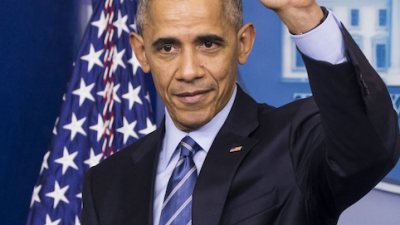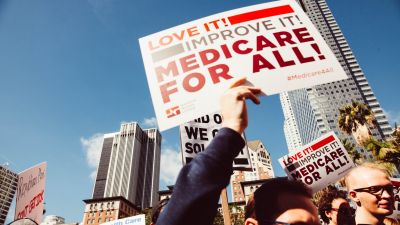
CDC Director Robert R. Redfield speaks as US President Donald Trump listens during the daily briefing on the novel coronavirus, which causes COVID-19, in the Brady Briefing Room of the White House on April 16, 2020, in Washington, DC. (Photo by MANDEL NGAN/AFP via Getty Images)
The director of the CDC has capitulated. Under the guise of “guidance,” Dr. Robert Redfield recently released a full-throated promotion of Trump’s latest pandemic talking points urging all schools to reopen in the fall. If he had based his action on the evolving medical evidence relating to COVID-19, it would have been appropriate. He didn’t. Instead, Dr. Redfield surrendered the independence and credibility of the CDC at a time when the country most needs scientific voices it can trust.
Dr. Redfield Plants His Flag
Mar. 29, 2018: A week after his appointment as CDC director, Dr. Redfield gives an emotional agency-wide address describing the honor of leading the best “science-based, data-driven agency in the world.” It is “science-based and data-driven, and that’s why the CDC has the credibility around the world that it has.”
May 19, 2020: The CDC issues guidance for ways “schools can help protect students, teachers, administrators, and staff and slow the spread of COVID-19.” Steps include personal hygiene, the use of cloth face coverings, staying home when appropriate, staggered scheduling, back-up staffing plans, modified seating layouts to allow social distancing, physical barriers, and closing communal spaces.
June 8: The American Association of School Superintendents estimates that compliance with the CDC’s recommendations will cost each school district in the country $1.8 million that they have not budgeted — a cost so prohibitive that some districts are scrapping plans for in-person classes entirely in the fall.
June 9: The American Federation of Teachers estimates that reopening schools safely and with the proper academic and emotional support in place will cost an additional $1.2 million per school, bringing the total necessary federal assistance to least $116.5 billion.
June 23: In response to a request from Sen. Lamar Alexander (R-LA), the Council of Chief State School Officers estimates that the cost to reopen schools safely will require $158 billion to $245 billion in federal assistance over the next two years. The House has passed a relief package that includes $100 billion for K-12 education, but the GOP-controlled Senate has no plans to consider the legislation. Among Republicans, only Sen. Alexander is making a major push for additional federal aid.
Dr. Redfield Moves His Flag Backward
July 7: Surrounded by supporters and members of his administration, including Secretary of Education Betsy DeVos, Trump announces that he wants all students returning to classrooms in the fall.
July 8: An internal 69-page CDC document details how schools can reopen safely. It cautions that “full sized, in-person classes, activities, and events” where “students are not spaced apart, share classroom materials or supplies, and mix between classes and activities” present the “highest risk” of increasing the spread of COVID-19. The document is not released publicly.
Also on July 8: Trump tweets disapproval of the CDC’s May 19 guidance: “I disagree with @CDCgov on their very tough & expensive guidelines for opening schools. While they want them open, they are asking schools to do very impractical things. I will be meeting with them!!!”
Also around July 8: After Trump’s critical comments, the Department of Health and Human Services convenes a working group to develop a statement pushing Trump’s agenda for reopening schools. CDC experts are “cut off from direct communication with the working group” after their input is interpreted as being “too cautious,” according to later reporting by The New York Times. The group still communicates directly with Dr. Redfield’s office, but “the CDC was by no means in charge.”
July 9: Dr. Redfield says that the CDC will issue “additional reference documents” to aid communities trying to reopen grades K through 12. But, he suggests, “it’s not a revision of the guidelines.”
July 12: Appearing on CNN, DeVos refuses to say whether schools should follow CDC guidelines in reopening. “The CDC guidelines are just that, meant to be flexible and meant to be applied as appropriate for the situation,” she says. “Kids need to be in school. They need to be learning, they need to be moving ahead.” Pressed repeatedly on whether schools should implement remote learning if there’s a flare-up of COVID-19 cases in their districts, DeVos says, “I think the go-to needs to be kids in school, in person, in the classroom.”
July 16: A South Korean study of more than 5,700 COVID-19 cases involving individuals who had contacts with 59,000 people concludes that children from ages 10 to 19 can spread COVID-19 at least as easily as adults.
Dr. Redfield Surrenders His Flag
July 23: Trump cancels the Republican National Convention in Jacksonville, saying, “The timing for this event is not right. It’s just not right with what’s happening lately — the flare-up in Florida — to have a big convention. It’s not the right time.”
Elaborating on his reasons, Trump later says, “Well, there’s nothing more crowded than a convention. A convention — I mean, you’ve seen them. And even though you try and keep people away from each other, it’s just not that kind of a thing. They probably can’t do that. It just doesn’t work for them. So it’s a very hard — so I think we’re setting an example…”
But during the briefing, Trump also proclaims that “every district should be actively making plans to open” their schools in the fall and threatens to withhold federal money from those that don’t, saying, “If schools do not reopen, the funding should go to parents to send their child to public, private, charter, religious, or homeschool of their choice.”
According to later reporting by The New York Times, “[O]ne White House official raised the question of sending inconsistent messages, asking how the president could continue pushing for schools to reopen if he was backing down from holding his own convention. Other aides, however, said opening schools was essential, and a mass gathering of Trump supporters — the majority of whom would be over 50 — was not…”
Nearly one-third of the nation’s apparently expendable public school teachers are over 50.
That same evening (July 23): The CDC publishes new “guidance” that includes an opening statement written by the Department of Health and Human Services’ “working group” titled “The Importance of Reopening America’s Schools This Fall.” It repeatedly describes children as being at low risk for COVID-19 infection or transmission, ignoring the contrary conclusions of the South Korean study published on July 16.
The director of the Harvard Global Health Institute, Dr. Ashish Jha, describes the new guidance as thin on what parents and teachers need most — “clear information on the risks to children of all ages, as well [as] to school staff.” Noting that it doesn’t mention a testing strategy and dismisses the importance of screening children for symptoms, Dr. Jha sees little “in the way of a strategy to prevent infections. I think that’s hugely problematic.” More succinctly, the deputy director of the Johns Hopkins Center for Health Security calls the CDC’s new statement a “sales job.”
The new guidance recommends that even in communities with “substantial, uncontrolled transmission, schools should work closely with local health officials to make decisions on whether to maintain school operations.” But, Dr. Jha notes, the CDC separately recommends that residents of such communities “shelter in place.” “It’s nonsensical that you would ask a community to shelter in place but keep schools open,” he tells the Times.
Dr. Redfield Surrenders the CDC
By acceding to Trump’s demands that put the entire nation at risk, Dr. Redfield has now damaged not only his professional reputation, but also the independence and credibility of the CDC.
Only 30 percent of registered voters trust Trump to tell the truth about COVID-19, and not coincidentally, about the same number (31 percent) believe that it’s safe to send kids to school in the fall. Before Dr. Redfield sacrificed himself and his agency on Trump’s political altar, 61 percent trusted the CDC. But now that Trump has co-opted Dr. Redfield and the White House is writing politically-based guidance published with the CDC’s imprimatur, to whom do most Americans turn now?
Creating that quandary may have been Trump’s real objective.
“If everybody always lies to you, the consequence is not that you believe the lies, but rather that nobody believes anything any longer,” German-American philosopher and political theorist Hannah Arendt, author of Eichmann in Jerusalem: A Report on the Banality of Evil, explained in a 1974 interview. “And a people that no longer can believe anything cannot make up its mind. It is deprived not only of its capacity to act but also of its capacity to think and to judge. And with such a people you can then do what you please.”
Read all installments of Steven Harper’s Pandemic Timeline.





